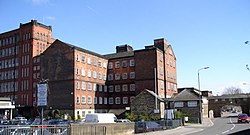Belper North Mill

Strutt's North Mill built in 1803, to replace the original one destroyed by fire
|
|
| Cotton | |
|---|---|
| Structural system | industrialised iron framed 'fire-proof' brick |
| Client | William Strutt |
| Coordinates | 53°01′42″N 1°29′13″W / 53.0282°N 1.4869°WCoordinates: 53°01′42″N 1°29′13″W / 53.0282°N 1.4869°W |
| Construction | |
| Built | 1804 |
| Floor count | 6 |
| Floor area | 127 feet (39 m) long by 31 feet (9.4 m) wide |
| Floor usage |
In 1804
|
| Design team | |
| Awards and prizes and listings | World Heritage Site |
| Water Power | |
| Wheels | 1 |
| Diameter / width of water wheel | 18 feet (5.5 m) / 23 feet (7.0 m) |
| Carding Equipment | 136 |
| Other Equipment |
1812
|
In 1804
1812
Belper North Mill, also known as Strutt's North Mill in Belper, is one of the Derwent Valley Mills, given UNESCO World Heritage Status in 2001.
The mill is sited in Belper, a town in Derbyshire, England, roughly halfway between Derby and Matlock.
The original North Mill, completed in 1786 by Jedediah Strutt, was destroyed by fire in 1803. Its replacement was built in 1804 by his son, William Strutt, on the foundations of the old mill and is one of the oldest surviving examples of an iron-framed 'fire-proof' building in the world.
In 2015 a report by Amber Valley Borough Council said the North Mill (and the Grade II listed East Mill) were in need of repair as they had suffered "significant damage", and the council was said to be was considering a compulsory purchase order.
The iron-framed mill is 127 feet (39 m) long by 31 feet (9.4 m) wide, 63 feet (19 m) high. It had two 41.5 feet (12.6 m) by 34 feet (10 m) wings.
Cotton mills were prone to fire as cotton dust ignites easily and the resulting fire burns through ceiling and floor timbers. This had happened to the earlier mill. In an attempt to prevent this happening experiments were made to construct a fireproof mill. The wooden beams supporting the floor timbers were replaced with beams of cast iron, (steel was not available till after 1860) and between them were low vaults made of brick with a 9 feet (2.7 m) span. Above this rubble was used to level the floor which was made of brick. The floor arches over the wheel pit were of a hollow clay construction.
The beams were cast in a "turtle back profile" to give the required strength, at minimum weight. They were supported by cast iron columns, erected on top of each other. The lateral thrust of the brick arches was resisted by concealed wrought iron ties between the column tops. The building was 15 bays wide, and the wings six bays wide.
...
Wikipedia

